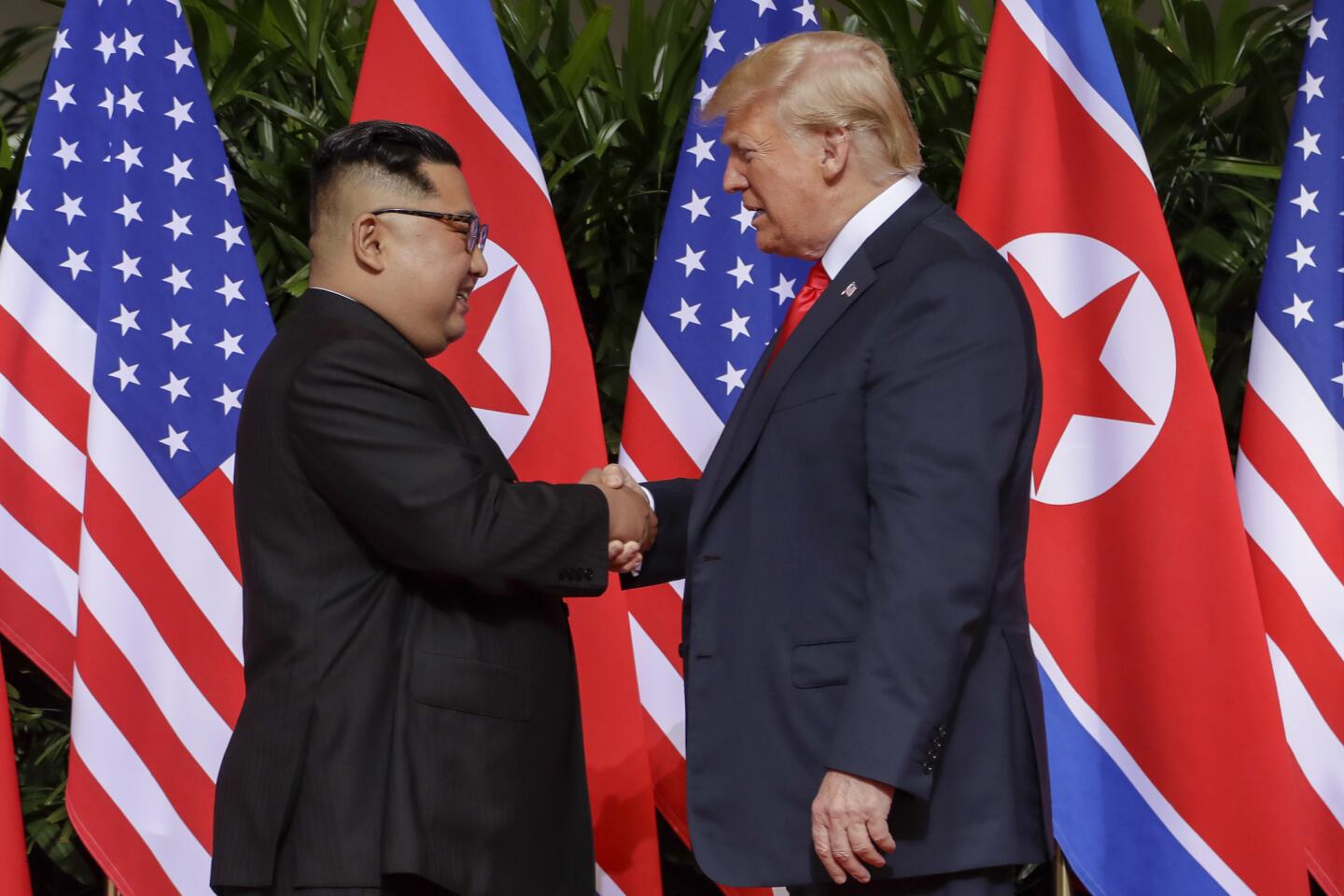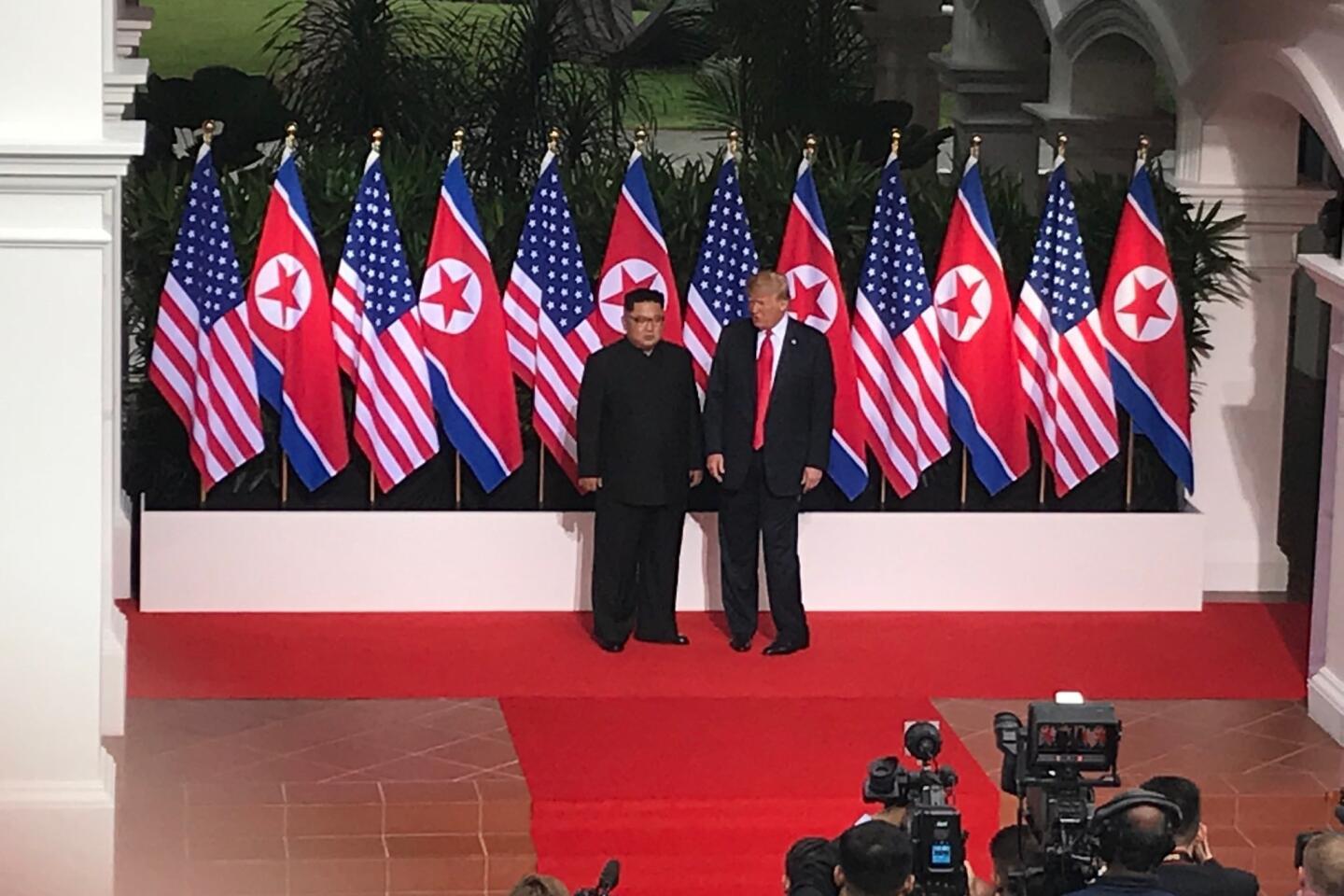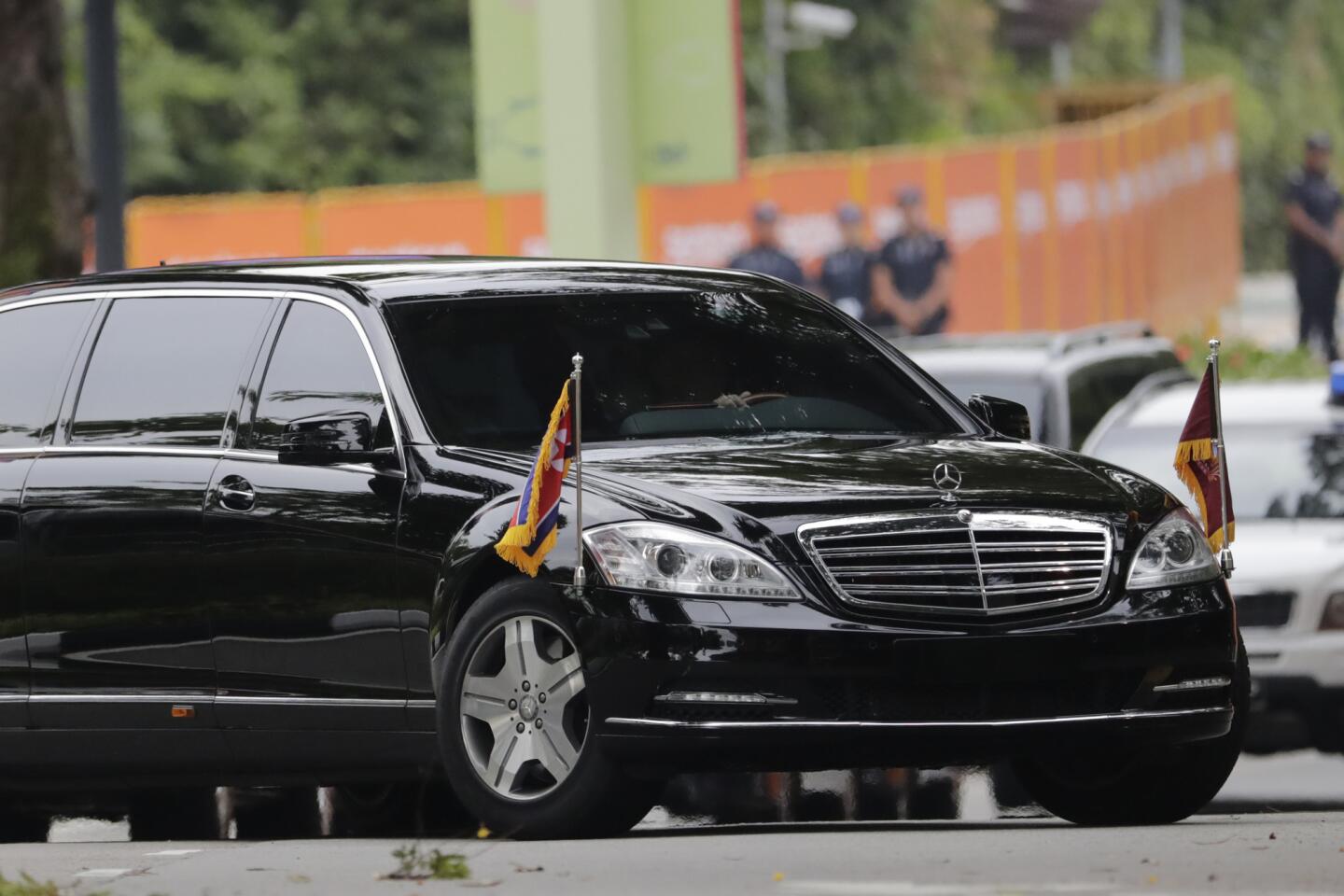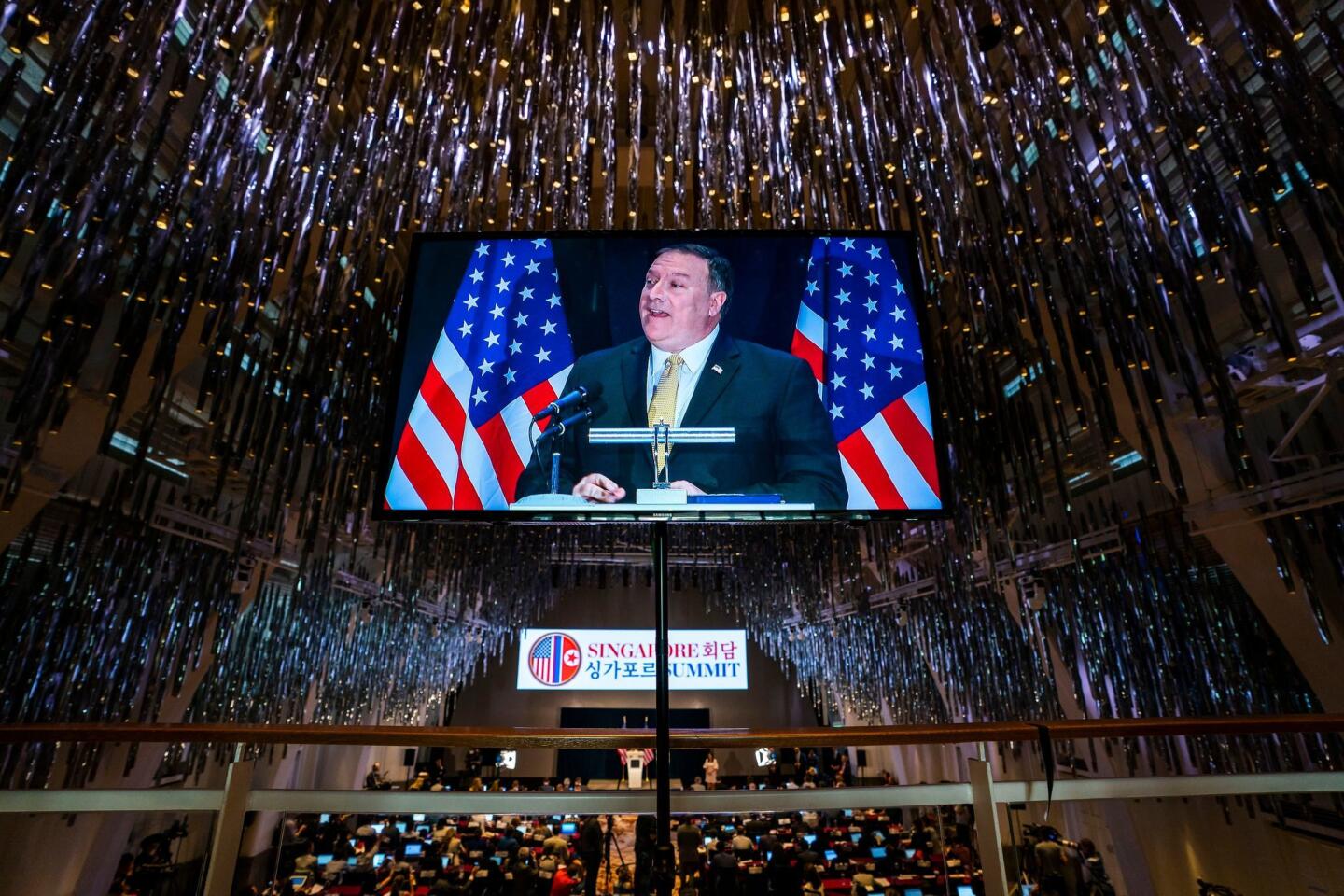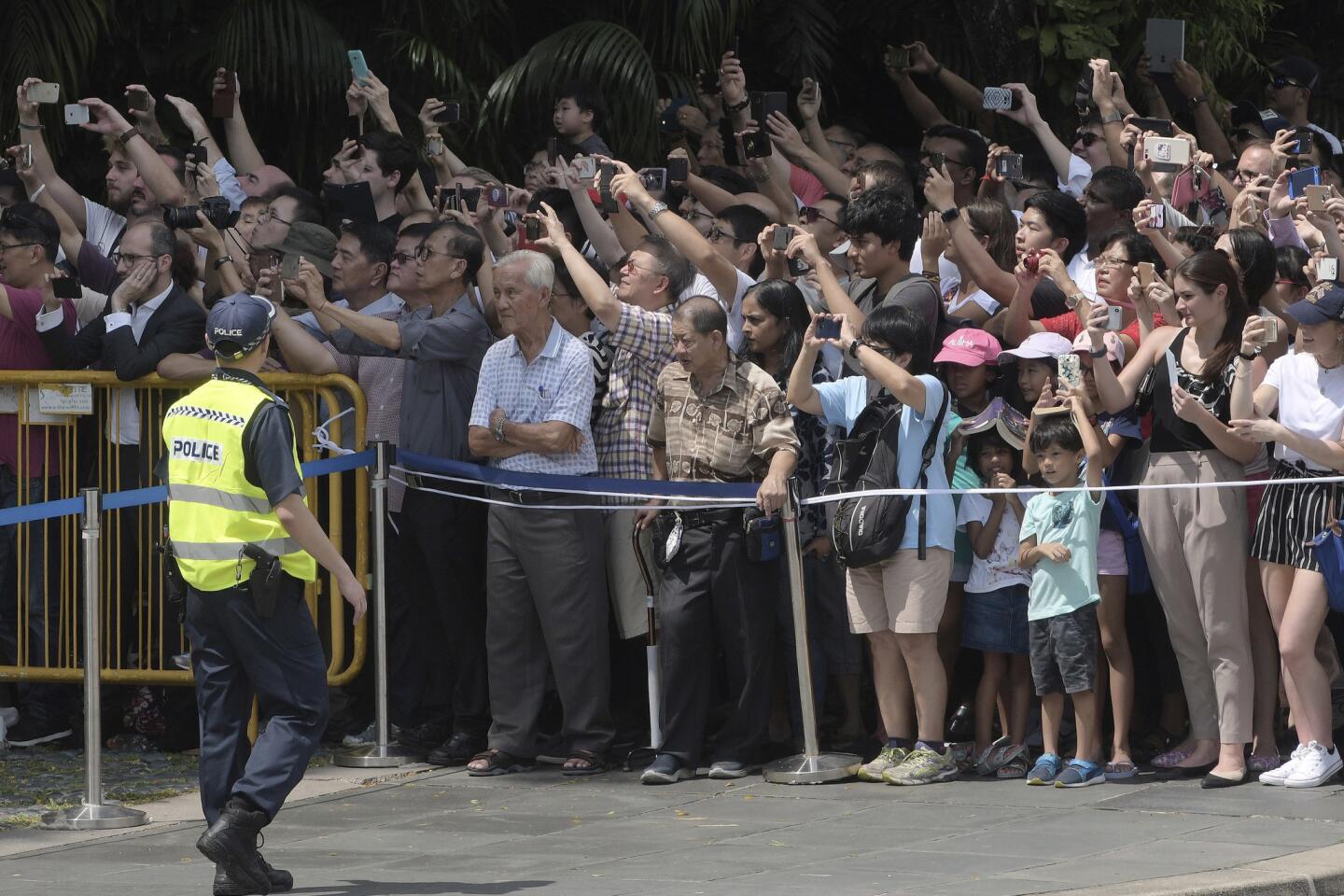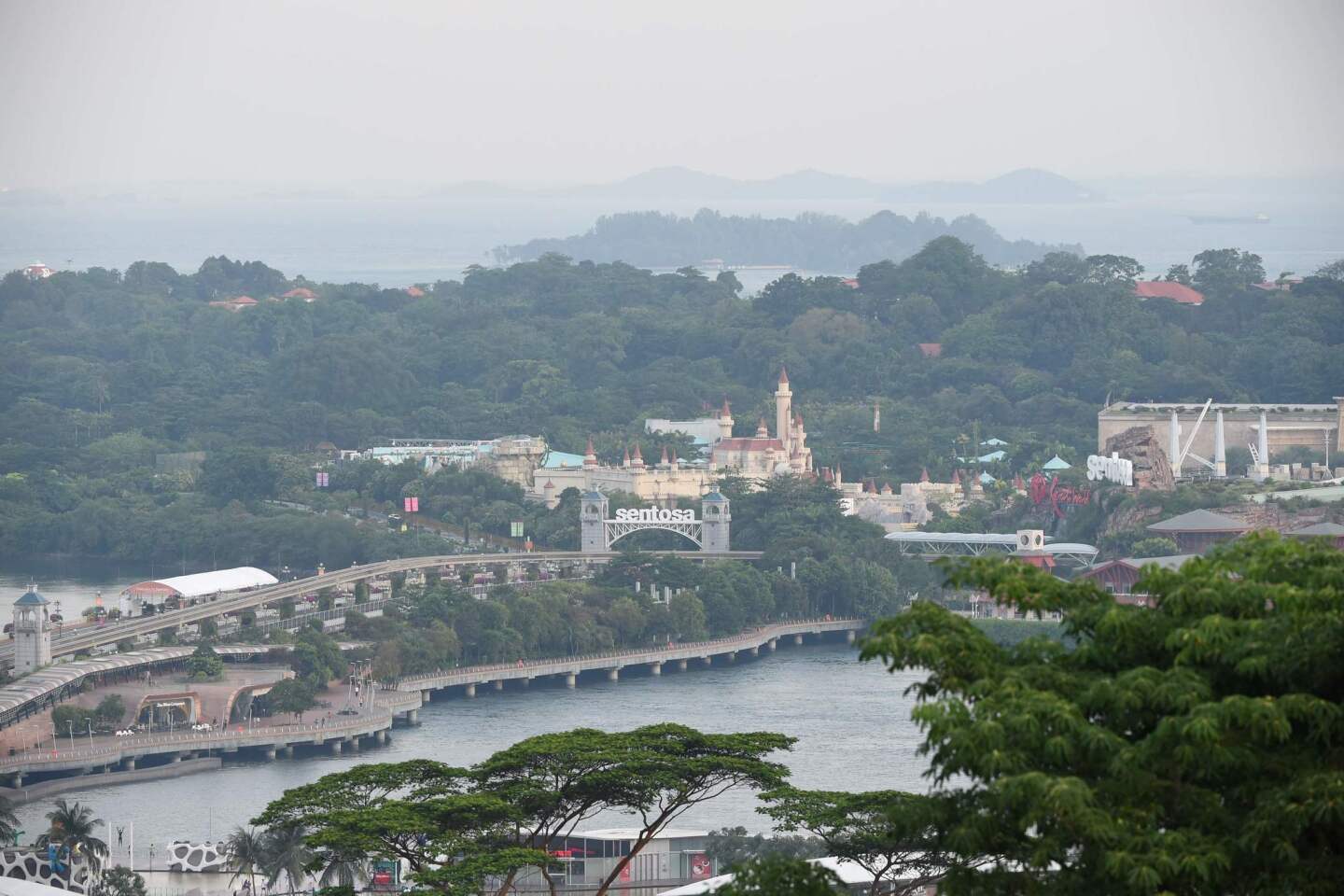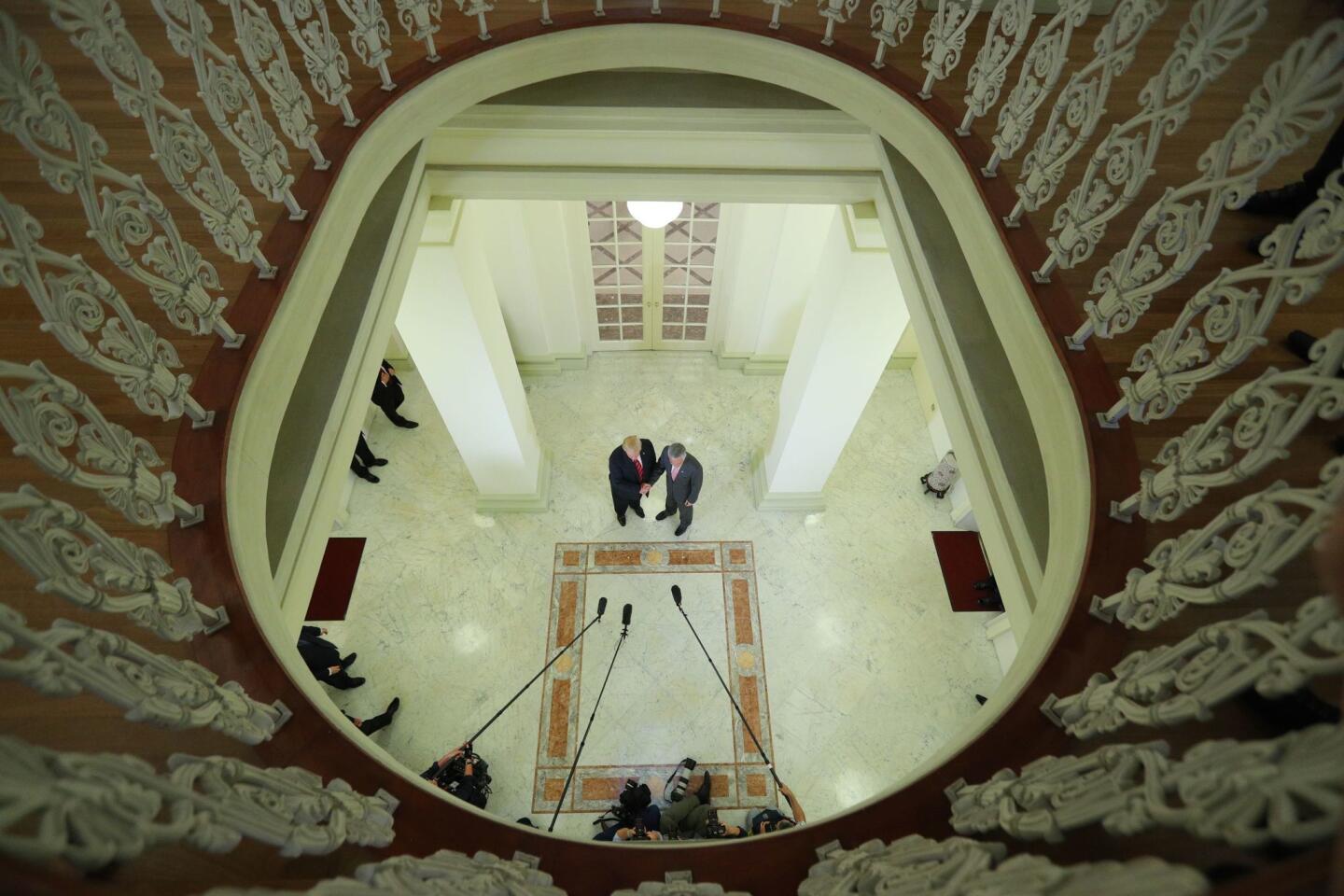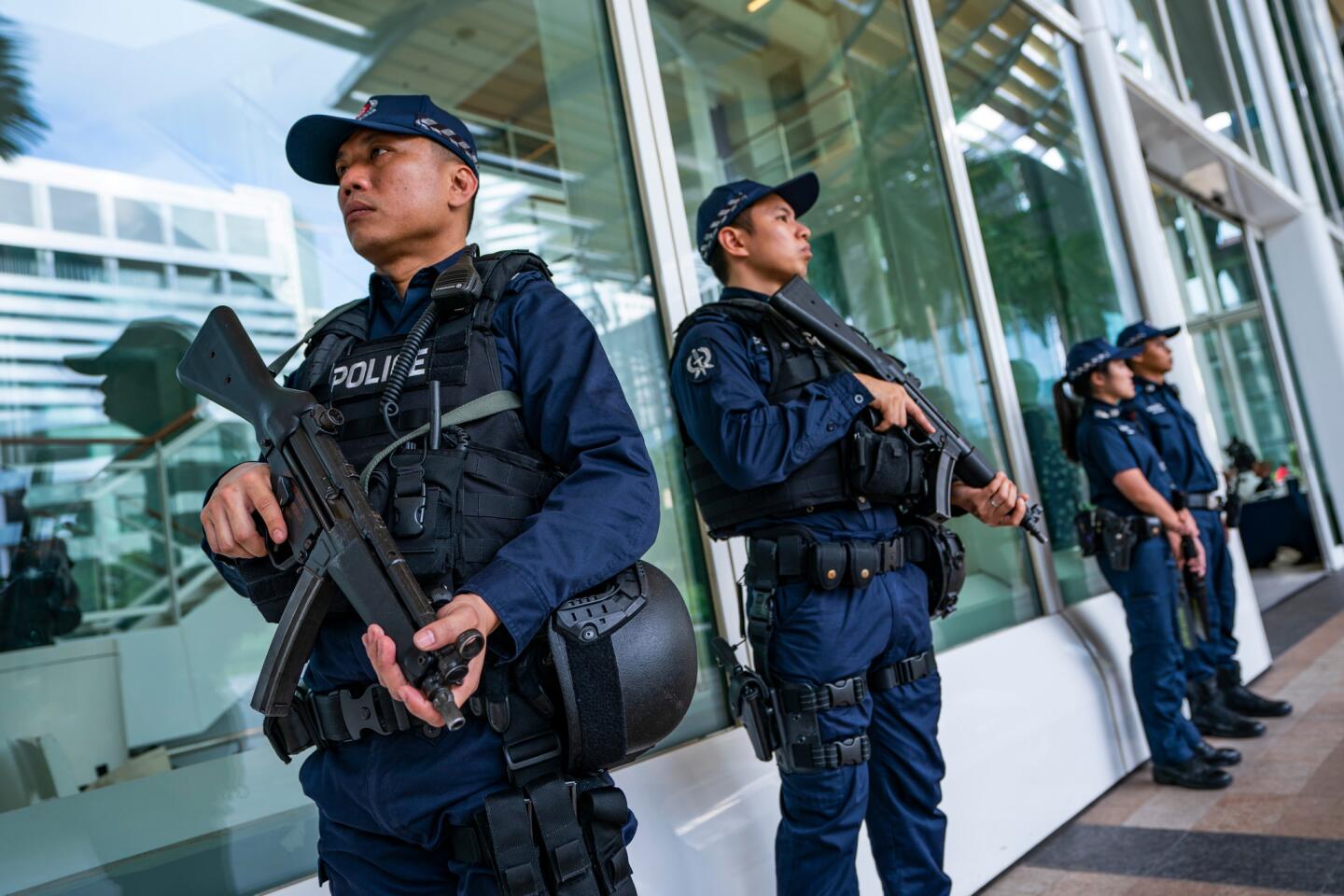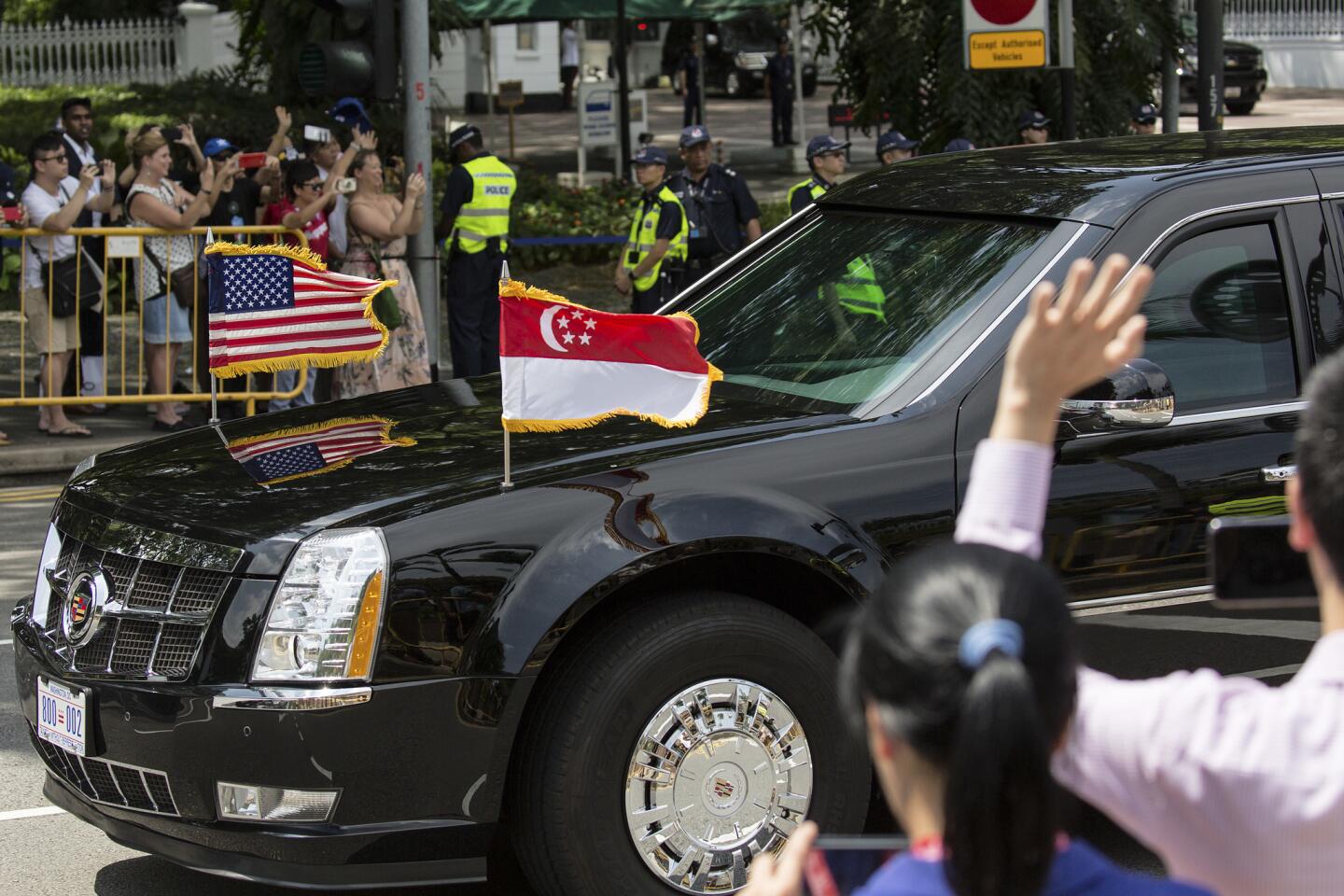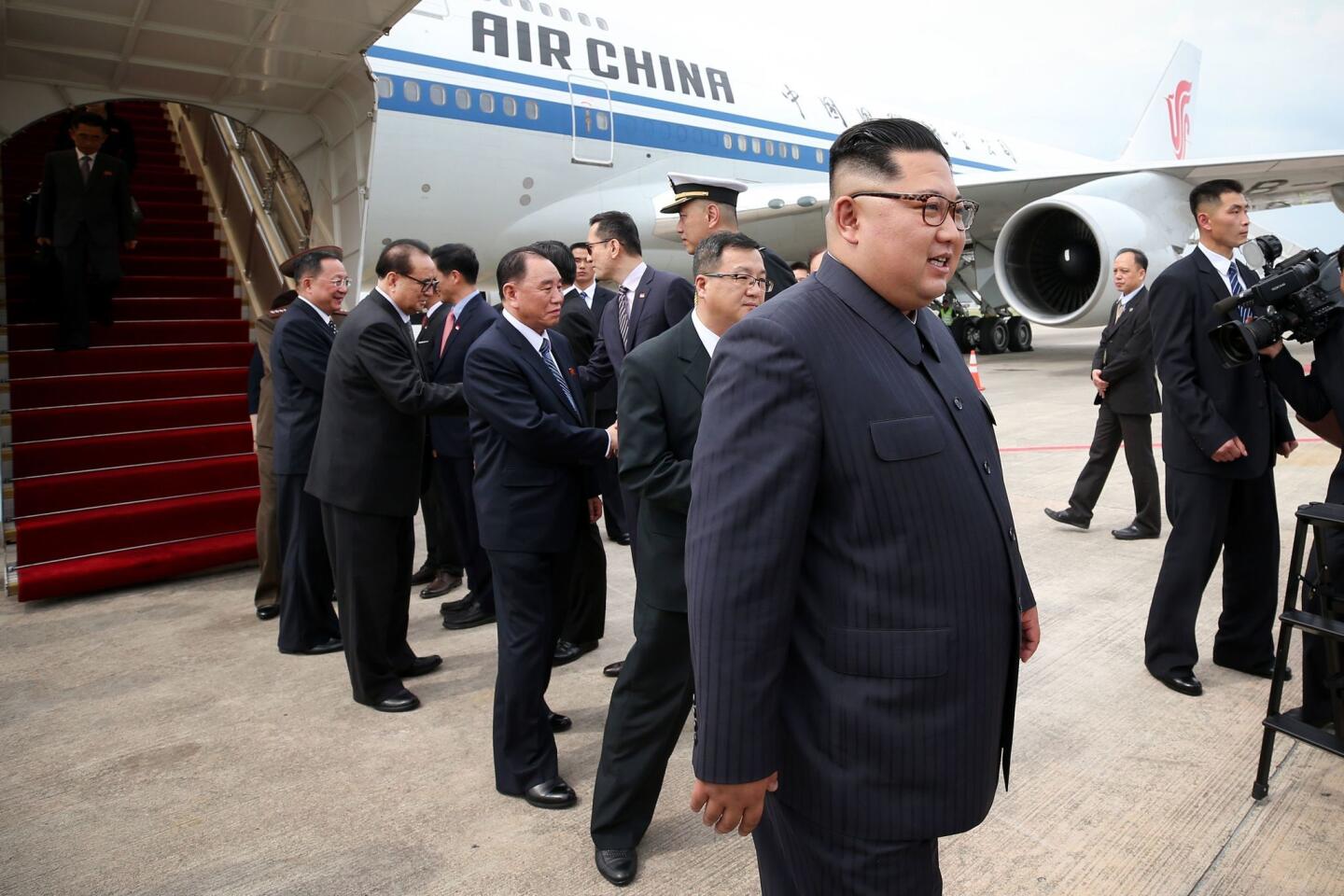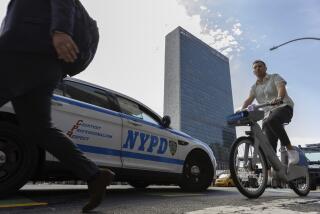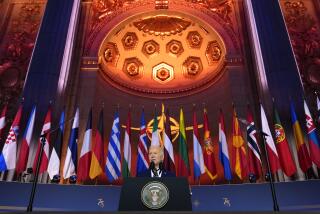Trump becomes first U.S. president to meet a North Korean head of state; ‘major change’ coming

The focus of the summit is the future of North Korea’s nuclear program.
Reporting from Singapore — With hearty handshakes, claps on the back and broad smiles for the cameras, President Trump and Kim Jong Un appeared to open a new chapter Tuesday in America’s long-hostile relations with North Korea as the two leaders spent a historic day of diplomacy aimed at ending the nuclear crisis on the Korean peninsula.
After meeting in private for 40 minutes and then together with senior aides for more than three hours, the world’s most powerful leader and arguably its most reviled signed three documents that they said turned the page on the past — although initial reports suggested the communique called for continued engagement but did not set a timeline for disarmament.
“The world will see a major change,” Kim said at a signing ceremony with Trump. The North Korean dictator said he and Trump “decided to leave the past behind.”
“We’ve developed a very special bond,” Trump said. He told reporters he “absolutely” would invite Kim to the White House, adding that they would meet “many times.”
The summit on Singapore’s Sentosa Island produced startling images of a U.S. president and a North Korean autocrat not just meeting for the first time, but standing shoulder to shoulder as equals before arrays of U.S. and North Korean flags, images long unimaginable in Kim’s isolated communist nation.
Kim arguably spoke for many earlier when he remarked, soon after meeting Trump, that the world probably viewed their improbable summit as “a form of fantasy … from a science fiction movie.”
The two men were initially stoic as they walked into the Capella Singapore hotel, Kim first and Trump several minutes later. They later came together from opposite sides of a gleaming white colonnade, exchanged a 13-second handshake and posed for photos, before sharing pleasantries in a side room.
Trump described meeting Kim as “a great honor.” Kim hinted at the three months of whirlwind developments leading to the first-ever meeting between a sitting U.S. president and a North Korean head of state.
“The past worked as fetters on our limbs, the old prejudices and practices worked as obstacles on our way forward, but we overcame all of them and we are here today,” Kim said through an interpreter.
“That’s true,” Trump responded.
The summit began with a private huddle, with only interpreters at Trump and Kim’s side. The conversation, without note takers or aides, was the latest sign of Trump’s norm-smashing approach to foreign affairs, where even one-on-one talks between leaders are usually carefully scripted and recorded.
The leaders were later joined by their senior aides, continuing their talks over a working lunch that featured such Korean dishes as stuffed cucumber and soy-braised cod, as well as Trump-friendly dishes like beef short rib confit and Haagen-Dazs ice cream.
Many Korea experts have cast grave doubt on the odds of winning a pact in the one-day summit that would compel Kim to give up his complete arsenal of nuclear, chemical and biological weapons in short order. Some warned that the summit would legitimize his isolated nation as a nuclear state.
Others saw glimmers of hope that the young autocrat would use the opportunity to strike a deal to pull North Korea out of widespread poverty and join some of its communist neighbors that have opened their economies and given their people a measure of autonomy.
Hours before the biggest meeting of his life, Kim made a move unthinkable in the seven-decade history of North Korea’s secretive, tyrannical government: He went sightseeing, in live view of hundreds of smartphone cameras.
Kim’s motorcade left his heavily fortified luxury hotel shortly after 9 p.m. Monday and headed to some of the busiest tourist destinations in downtown Singapore, including the rooftop of the Marina Bay Sands hotel and the Jubilee Bridge.
Surrounded by his entourage, a throng of bodyguards and Singapore government officials, Kim took in the sights and basked in camera flashes, greeted by a curious and buzzy crowd everywhere he went. He even posed, smiling, for a selfie snapped by Singapore’s foreign minister, Vivian Balakrishnan.
By Tuesday morning, high-definition photos of Kim’s jaunt about the affluent island nation and his rock-star-like welcome were on the front pages of newspapers in Pyongyang, the North Korean capital. The casual approach was in direct contrast to that of his father and grandfather, who were seen only in staid, staged images issued by state media.
The fanfare was a rare upstaging for Trump, who spent a quiet evening largely out of sight.
Up to the moment coverage of the Singapore summit »
Among those watching Trump and Kim meet live on television was South Korean President Moon Jae-in, who brokered the summit between a longtime ally and a neighboring nuclear-armed foe. In a Cabinet meeting Tuesday, he said he had a sleepless night. “All of Korea’s attention is probably trained on Singapore,” he said.
The White House said Monday that the preliminary talks “moved more quickly than expected” and that the summit would wrap up in one day. Trump was expected to leave Singapore on Tuesday night, a day earlier than originally planned.
Secretary of State Mike Pompeo said Trump could go further than previous presidents in trying to make a deal, suggesting the president was willing to ease Kim’s concerns about America’s military posture and security guarantees to allies in Northeast Asia as long as North Korea gives up its unconventional weapons.
“We’re prepared to take what will be security assurances that are different, unique than … [what] America has been willing to provide previously,” Pompeo said.
Pompeo refused to say whether Trump was considering withdrawing or reducing the 28,000 U.S. troops in South Korea, but his language suggested an openness to realigning the U.S. military presence and operations in the region, a long-held North Korean demand.
North Korea is also eager for the United States to lower its so-called nuclear umbrella, a shield that is guaranteed under long-standing defense treaties with South Korea and Japan in the event of an attack from North Korea.
The U.S. foreign policy establishment considers an easing of the U.S. regional defense posture risky and highly inadvisable as long as North Korea maintains its nuclear, chemical and biological weapons, and a million-man army that mostly is deployed near the border with South Korea.
Security experts have warned that any pullback of U.S. forces would undermine decades of postwar alliances and allow China to accelerate its efforts toward regional dominance.
Even as Pompeo floated the apparent U.S. concessions, he took a hard line on what the Trump administration would demand in return. He said economic sanctions would remain in place “until North Korea completely and verifiably eliminates its weapons-of-mass-destruction programs.”
If taken at face value, the full elimination of North Korea’s extensive storehouse of nuclear, chemical and biological weapons could take years, making the prospect a tough sell to Kim, given the crippling effects of Trump’s “maximum pressure” sanctions program on North Korea’s economy.
But Pompeo said Trump would quickly determine at the summit whether Kim was serious about his offer to denuclearize, even though the two sides have never publicly agreed on what that would entail.
“North Korea has previously confirmed to us its willingness to denuclearize, and we are eager to see if those words prove sincere,” he said.
Pompeo continued to downplay the possibility of an immediate accord between Trump and Kim, suggesting a successful outcome would simply be further engagement between Washington and Pyongyang.
The discussions “will set the framework for the hard work that will follow,” he said.
It was the latest scaling back of Trump’s initial soaring optimism for a speedy disarmament agreement or a peace treaty to formally end the 1950-53 Korean War; he once even suggested that North and South Korea might want to hold a large celebration after he and Kim met.
Instead, Pompeo made clear that the U.S. team was fully aware of the long record of failed negotiations with North Korea, usually after the U.S. side accused Pyongyang of cheating or failing to fulfill its promises to curb its nuclear or missile programs.
“The United States has been fooled before. There’s no doubt about it,” he said. “Many presidents previously have signed off on pieces of paper only to find out the North Koreans either didn’t promise what we thought they had or actually reneged on their promises.”
At his news briefing, Pompeo made no mention of human rights. Critics have urged Trump to demand that Kim reform his repressive government, which the State Department has accused of assassinating dissenters and jailing tens of thousands of prisoners to maintain its grip.
Up until Monday evening, North Korean Vice Foreign Minister Choe Son Hui and U.S. envoy Sung Kim continued last-minute working-level negotiations on a possible agreement for Trump and Kim to present as tangible results from their summit.
Traditionally, summits between heads of state follow months of lower-level meetings in which officials work out a deal, haggling over every clause and comma, while choreographing the interactions of the top leaders in advance.
This summit was proposed only three months ago and finalized less than two weeks ago after a tense period of roller-coaster will-they-or-won’t-they diplomacy.
The two sides did not put forward a public agenda as they made final preparations.
Trump has vacillated over his objectives for the meeting with Kim. At first he said he would accept nothing less than swift and permanent nuclear disarmament from North Korea.
More recently, he has allowed that the summit could start a longer process and that it would be a “get to know you plus” meeting with a reclusive adversary.
Pompeo, who has been Trump’s most influential advisor on North Korea, said the United States remains “committed to the complete, verifiable, irreversible denuclearization” of the Korean peninsula.
That has long been official U.S. policy and represents a hard line that some advisors and outsiders have suggested could bend if Trump and Kim are able to reach a deal.
David Kang, a professor at at USC who heads its Korean Studies Institute, said that he expected little of substance from the summit but that the diplomatic process still represented significant change for North Korea and the region.
“This is a photo op,” he said.
[email protected] | Twitter: @Noahbierman
UPDATES:
11:54 p.m.: Updated with the conclusion of the meeting among Trump, Kim and their aides.
9:57 p.m.: Updated with further comments from the summit.
7:18 p.m.: Updated with the leaders’ comments.
6:05 p.m.: Updated with their meeting.
This article was first posted at 8:30 a.m.
More to Read
Sign up for Essential California
The most important California stories and recommendations in your inbox every morning.
You may occasionally receive promotional content from the Los Angeles Times.
